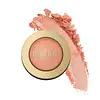What's inside
What's inside
 Key Ingredients
Key Ingredients

 Benefits
Benefits

No benefits
 Concerns
Concerns

 Ingredients Side-by-side
Ingredients Side-by-side

Water
Skin ConditioningHydrogenated Didecene
Skin ConditioningIsododecane
EmollientMica
Cosmetic ColorantGlycerin
HumectantPropanediol
SolventCetyl PEG/PPG-10/1 Dimethicone
EmulsifyingSilica
AbrasiveSodium Chloride
MaskingHydrogenated Styrene/Isoprene Copolymer
Hydroxyacetophenone
AntioxidantPolyglyceryl-4 Isostearate
Emulsifying1,2-Hexanediol
Skin ConditioningCaprylyl Glycol
EmollientTriethoxycaprylylsilane
Trisodium Ethylenediamine Disuccinate
Pentaerythrityl Tetra-Di-T-Butyl Hydroxyhydrocinnamate
AntioxidantLindera Strychnifolia Root Extract
Skin ConditioningPhenoxyethanol
PreservativeEthylhexylglycerin
Skin ConditioningCI 77891
Cosmetic ColorantCI 77491
Cosmetic ColorantCI 45405
Cosmetic ColorantWater, Hydrogenated Didecene, Isododecane, Mica, Glycerin, Propanediol, Cetyl PEG/PPG-10/1 Dimethicone, Silica, Sodium Chloride, Hydrogenated Styrene/Isoprene Copolymer, Hydroxyacetophenone, Polyglyceryl-4 Isostearate, 1,2-Hexanediol, Caprylyl Glycol, Triethoxycaprylylsilane, Trisodium Ethylenediamine Disuccinate, Pentaerythrityl Tetra-Di-T-Butyl Hydroxyhydrocinnamate, Lindera Strychnifolia Root Extract, Phenoxyethanol, Ethylhexylglycerin, CI 77891, CI 77491, CI 45405
Talc
AbrasiveMica
Cosmetic ColorantGlyceryl Ethylhexanoate/Stearate/Adipate
EmollientDimethicone
EmollientOctyldodecyl Stearoyl Stearate
EmollientIsopropyl Myristate
EmollientPolyacrylamide
C13-14 Isoparaffin
EmollientLaureth-7
EmulsifyingSorbitan Stearate
EmulsifyingZea Mays Starch
AbsorbentLauroyl Lysine
Skin ConditioningMagnesium Aluminum Silicate
AbsorbentCetearyl Ethylhexanoate
EmollientSodium Dehydroacetate
PreservativeNylon-12
Imidazolidinyl Urea
PreservativeMethylparaben
PreservativeSilica
AbrasiveEthylparaben
PreservativePropylparaben
PreservativeButylparaben
MaskingCI 77891
Cosmetic ColorantCI 77491
Cosmetic ColorantIron Oxides
CI 19140
Cosmetic ColorantCI 15850
Cosmetic ColorantCI 15985
Cosmetic ColorantCI 75470
Cosmetic ColorantCI 77007
Cosmetic ColorantTalc, Mica, Glyceryl Ethylhexanoate/Stearate/Adipate, Dimethicone, Octyldodecyl Stearoyl Stearate, Isopropyl Myristate, Polyacrylamide, C13-14 Isoparaffin, Laureth-7, Sorbitan Stearate, Zea Mays Starch, Lauroyl Lysine, Magnesium Aluminum Silicate, Cetearyl Ethylhexanoate, Sodium Dehydroacetate, Nylon-12, Imidazolidinyl Urea, Methylparaben, Silica, Ethylparaben, Propylparaben, Butylparaben, CI 77891, CI 77491, Iron Oxides, CI 19140, CI 15850, CI 15985, CI 75470, CI 77007
 Reviews
Reviews

Ingredients Explained
These ingredients are found in both products.
Ingredients higher up in an ingredient list are typically present in a larger amount.
Ci 77491 is also hydrated iron III oxide. It's sole purpose is to give a red/pink hue to products.
Iron III oxides are classified as inorganic chemicals for coloring.
Synthetically created Ci 77491 is considered safer than those naturally found. This is because the synthetically created version may contain less impurities. Iron oxides are generally non-toxic and non-allergenic.
Learn more about CI 77491Ci 77891 is a white pigment from Titanium dioxide. It is naturally found in minerals such as rutile and ilmenite.
It's main function is to add a white color to cosmetics. It can also be mixed with other colors to create different shades.
Ci 77891 is commonly found in sunscreens due to its ability to block UV rays.
Learn more about CI 77891Mica is a naturally occurring mineral used to add shimmer and color in cosmetics. It can also help improve the texture of a product or give it an opaque, white/silver color.
Serecite is the name for very fine but ragged grains of mica.
This ingredient is often coated with metal oxides like titanium dioxide. Trace amounts of heavy metals may be found in mica, but these metals are not harmful in our personal products.
Mica has been used since prehistoric times throughout the world. Ancient Egyptian, Indian, Greek, Roman, Aztec, and Chinese civilizations have used mica.
Learn more about MicaSilica, also known as silicon dioxide, is a naturally occurring mineral. It is used as a fine, spherical, and porous powder in cosmetics.
Though it has exfoliant properties, the function of silica varies depending on the product.
The unique structure of silica enhances the spreadability and adds smoothness, making it a great texture enhancer.
It is also used as an active carrier, emulsifier, and mattifier due to its ability to absorb excess oil.
In some products, tiny microneedles called spicules are made from silica or hydrolyzed sponge. When you rub them in, they lightly polish away dead skin layers and enhance the penetration of active ingredients.
Learn more about Silica